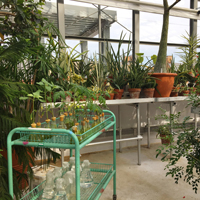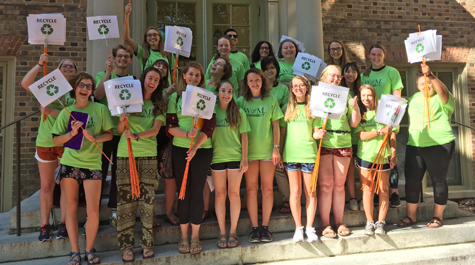W&M announces 2019 spring, summer Green Fee projects
William & Mary’s Committee on Sustainability recently awarded 15 Green Fee grants totaling $94,846 for sustainability-related projects at the university.
The projects — 12 funded by spring grants and three through summer research grants — include a greenhouse outreach program, a plastic reduction effort in the Raymond A. Mason School of Business, the digitalization of Sadler Center advertisement space and more.
Since its establishment in 2008, the William & Mary Green Fee has funded more than $1 million worth of sustainability projects led by students, faculty and staff, representing different aspects of sustainability on campus.
The Green Fee program advances W&M's interests in sustainability, its general operations and the university's tri-partite missions of teaching, research and public service. The Committee on Sustainability (COS) accepts proposals every semester.
This semester, W&M Sustainability also gathered stakeholders across campus to work on goals for the university’s long-range, comprehensive Sustainability Plan, covering years 2019-2024. One of the upcoming commitments is the launch of a Green Events Guide, to provide guidance to event planners on how to reduce carbon footprint when hosting events. W&M Sustainability is also working toward a Climate Action Plan, setting an ambitious carbon neutrality date.
This spring’s Green Fee projects are:
Bird Safety Film at VIMS
$11,500 to Meredith Seeley, Mark Rogers, Amber Hall, the VIMS Green Team and advisor, Mark Brabham, Director of Facilities Management
The campus of W&M’s Virginia Institute of Marine Science is located on the York River. Several of its buildings are constructed with large areas of glazing that pose hazards to local birds. This funding will be used to install bird safety film on one of the buildings where bird strikes are commonly reported, a portion of Davis Hall, in order to deter birds from flying towards reflective surfaces. Following installation, VIMS will track the bird casualties at this location compared to others, so that recommendations may be made about installing the film in other areas across the campus in the future.
Comparison of Mummichogs and Atlantic Silversides Fish Populations from Living Shoreline and Natural Marshes
$1,500 to Emma Butler and advisors Amanda Guthrie and Randy Chambers, Professor of Biology and Director of the W.M. Keck Environmental Field Laboratory
This project will evaluate two species of marine fishes, Mummichogs (Fundulus heteroclitus) and Atlantic Silversides (Menidia menidia) and their respective growth patterns within natural marshes and living shorelines. Living shorelines are typically narrow stretches (less than 20m wide) of manmade low and high marsh vegetation that provide a foundation for further ecological growth of populations of the two fish species proposed for study (Bilkovic et al., 2016). The researchers will assess whether these fish species can be supported and sustained by living shorelines, as living shorelines will become an important tool in developing more resilient coastlines along the Chesapeake Bay in response to ongoing habitat loss.
EcoReps Freshmen Move-In Day
$996 to Jenny Fam M.Ed. ’20 and Calandra Waters Lake, Director of Sustainability
The EcoReps program was launched in fall 2018 by the Office of Sustainability. EcoRep volunteers assisted in recycling during Freshmen Move-In Day, aimed to reduce waste while increasing sustainability awareness on campus. The program was a success and the Office of Sustainability is utilizing this funding to expand the program, providing additional materials to EcoReps and setting up rigid yard signs to better direct students, parents and guests to the recycling areas during Move-In Day.
Event-2-HVAC Phase 1
$30,000 to Farley Hunter, Associate Director Operations
Event-2-HVAC software integrates the university’s event management system and the building automation system for select buildings in this first phase. After integration, schedulable spaces will have reduced airflow and relaxed space temperature requirements during unoccupied periods. Reduced unnecessary airflow and space conditioning lowers electric and natural gas consumption thereby shrinking the university’s carbon footprint.
Faculty & Staff Professional Development Pilot
$900 to Calandra Waters Lake, Director of Sustainability
In an effort to increase the application of sustainability among W&M faculty and staff, this pilot will fund professional development opportunities, up to $300 each, for a minimum of three grants. The goal is to provide incentives and accessibility for faculty and staff to attend workshops, conferences, webinars and other profession specific opportunities that increase the understanding and incorporation of sustainability across the campus.
 Greenhouse Outreach Program
Greenhouse Outreach Program
$1,000 to Katie Stahl ’19, Mary Bea Halloran ’20 and Joshua Puzey, Professor of Biology
Currently, the greenhouse is tucked away with few visitors. The goal of this project is to make the on campus greenhouse more accessible to both W&M students and the broader Williamsburg community. The project also seeks to facilitate education and involvement with conservation. These goals will be facilitated by hosting events such as school field trips and planting sessions and running educational outreach efforts at relevant events such as Earth Day and the local farmer's market.
Interior Recycling Project
$10,000 to Building Services and Facilities Management (Bob Morman, Director)
Using a Green Fee award of $5,000 in 2017, Building Services initially installed new recycling receptacles in three academic buildings: Washington Hall, James Blair Hall and McGlothlin Street Hall and monitored their usage for 12 months. During that period, nearly 2,000 pounds of recyclables were collected and diverted from the campus waste stream. Based on that success, two more buildings — Small Hall and Swem Library — were added in early 2019. Monitoring of all five buildings continues. In spring 2019, Building Services requested and received a second Green Fee award, this time in the amount of $10,000. With the second award, Building Services plans to expand interior recycling receptacles to another eight buildings: Adair Hall, Andrews Hall, Blow Hall, Ewell Hall, Jones Hall, Miller Hall, the School of Education and Undergraduate Admission. If there are funds remaining, additional academic buildings will be identified. When all 13 projected buildings are outfitted with the new receptacles, our expectation is that 8,000-10,000 pounds of recyclables will be collected annually. The goal is to increase the number of recycling collection points on campus by at least 10% per year through 2023 and to increase the campus diversion rate to 40% also by 2023.
MBA’s Plastic Reduction Project
$5,000 to Francesca Costantino ’20 and Juliana Olm Cunha ’20, and advisors Carlane Pittman and Michael Luchs
Plastics pollution is becoming the next critical environmental challenge, as symbolized by the Great Pacific garbage patch. This integrated pilot program aims to educate the W&M community, raise awareness to the negative effects of plastics usage and inspire people to adopt more sustainable practices by reducing single-use plastics at Raymond A. Mason School of Business, to begin the process of changing habitual patterns of unsustainable consumption. It involves marketing and educational campaigns, product development, design-thinking sessions, market research and partnerships with suppliers across the campus to create incentives and implement facility changes. One of the highlights of this project is the development and distribution to students, faculty and staff of “green kits” (reusable utensils, straw, lunch bag and drinkable mugs) as an incentive to decrease usage of plastic items at campus dining areas.
Reinstituting Recycling in Freshman Dorms
$2,100 to Marie Serfis ’19, Griffin Bird ’19, Max Maiello ’19 and Josh Panganiban ’20, Student Assembly Sustainability and advisor Jessica Raymond, Residence Life
Currently, recycling bins in campus residences are being misused as trash receptacles. Trash cans will be purchased and supplied to freshman dorms so that students will be more likely to sort their recyclables from the trash and properly recycle. Through the completion of the project, the number of people who recycle is expected to increase and the use of recycling bins as trash cans is expected to decrease. This will be evaluated in a survey to assess the feasibility of furthering this project to other areas of on-campus residences.
Sadler Center Digital Posters
$10,000 to Sophia Ramsey, Visual Design Coordinator for Sadler and Campus Center, and Chandler Agett, Assistant Director for Technical Services for Sadler and Campus Center
The Sadler Center is planning an update to its current advertisement space by replacing the printed poster boards in the entrance of the building with four digital displays. The update will save an estimate of 3,888 square feet of paper from ending up in landfills each year, by eliminating the need for printed posters. This will also be a free resource for students who want to advertise their events.
Summer Curriculum Grants Pilot
$4,500 to Calandra Waters Lake, Director of Sustainability
This award will be divided into four summer curriculum grants, made available by application to any W&M/VIMS faculty for increasing/incorporating sustainability content into an existing course that does not currently explicitly address sustainability. At a minimum, the course would meet the level of “sustainability related” in the university’s course count and carry the SUST attribute so that students may more easily identify it.
Sustainability Workshops Pilot
$2,000 to Calandra Waters Lake, Director of Sustainability
Up to six campus sustainability workshops will be made available to all interested faculty, staff and students. The workshops will be held around the lunch hour to accommodate as many schedules as possible and food will be provided to any that register in advance. These learning opportunities will focus on sharing campus sustainability best practices across multiple dimensions and will be an added resource to the W&M community.
This year’s summer projects are:
“AIRduino”: On-Demand New Particle Formation Measurements with a Handheld Arduino Multisensor
$5,450 to Kelly Rodriguez-Vasquez '20 and advisor Nathan Kidwell, Assistant Professor of Chemistry
New Particle Formation (NPF) is the transformation of gas phase molecules into aerosols. Aerosols have a detrimental effect on energy balance, public health, and climate. Aerosols have the ability to absorb or reflect solar radiation which has a large impact on radiative forcing. The researchers created a multisensor device (“AIRduino”) using an Arduino microcontroller connected with sensors to simultaneously record gas phase molecule and aerosol concentrations on demand to monitor NPF. Paired with an Android smartphone app via Bluetooth the mobile and real-time capabilities of the device allow for greater geographical coverage and greater accessibility of NPF measurements. In collaboration with NASA Langley Research Center and W&M’s Virginia Institute of Marine Science (VIMS), the researchers’ goals will be to analyze how the regional chemical composition of the atmosphere influences aerosol formation.
Population Status and Nesting Ecology of Diamondback Terrapins
$4,450 to Justin Mitchell '20 and advisor Randy Chambers, Professor of Biology and Director of the W.M. Keck Environmental Field Laboratory
Diamondback Terrapins are an important part of the Chesapeake Bay ecosystem and function as ecosystem engineers in its submerged aquatic vegetation beds assisting in seed dispersal. These species were harvested to near extinction during the early 20th century and though efforts have been made to restore the charismatic species little is known about their population levels and distribution. Recent ENSP honor’s research by Holly Funkhouser developed a GIS-based model of terrapin occurrence in the Chesapeake Bay and it predicts that the Catlett Islands are a possible location for terrapin nesting. This experiment will look at the accuracy of the GIS-based model as well as study the nesting habits of this species, helping to further our understanding of these ecosystem engineers and their contributions to the submerged aquatic vegetation that is vital to the health of the Chesapeake Bay, as well as help the William & Mary community sustainability efforts reach out across the entire watershed.
Relationship Between Common Milkweed and Milkweed Beetle
$5,450 to Jason Dean Robinson ’22 and advisor Harmony Dalgleish, Assistant Professor of Biology
 Skip to main content
Skip to main content

